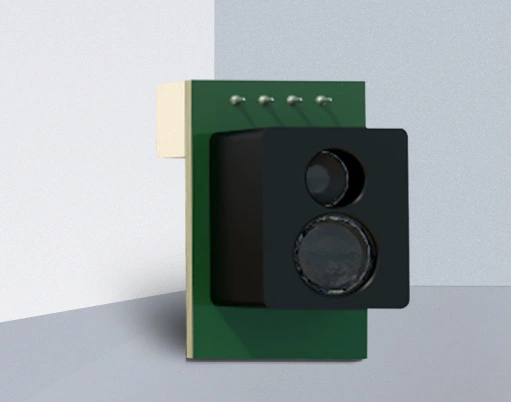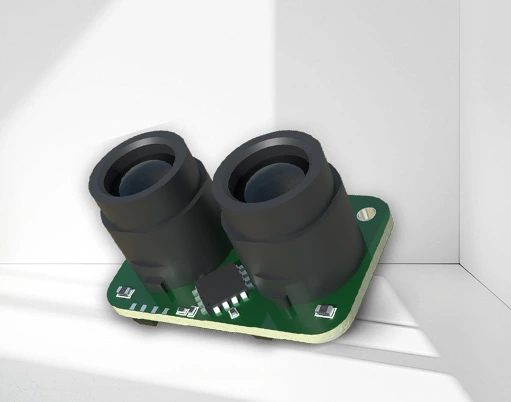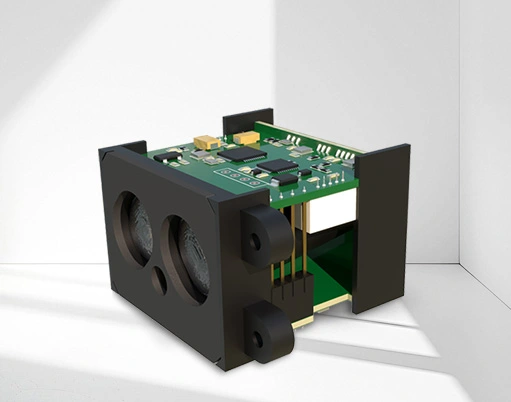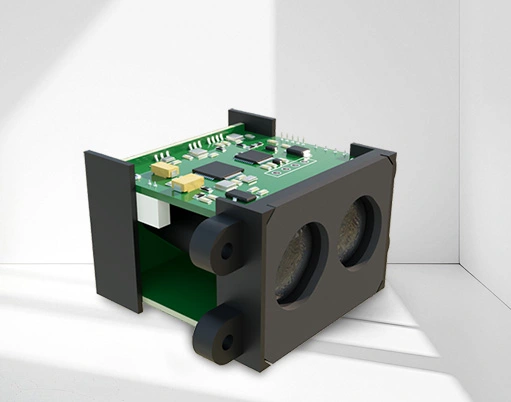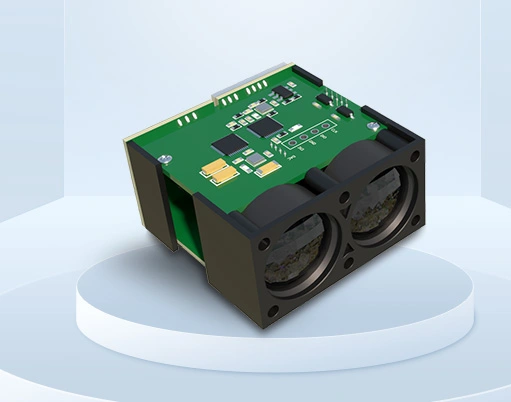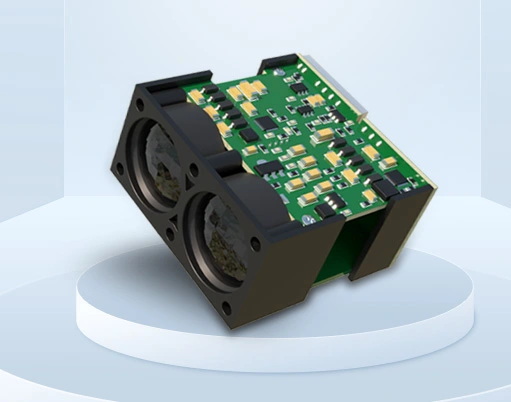1、 Introduction
In the efficient operation system of modern airports, the smooth flow of luggage and cargo is crucial. As a key carrier for luggage and cargo transportation, accurate monitoring of the status of empty containers is indispensable. Laser ranging sensors, with their unique advantages, have emerged in the field of airport empty container measurement, providing strong support for ensuring transportation efficiency, improving safety, and optimizing resource allocation.
2、 Analysis of the Working Principle of Laser Ranging Sensor
(1) Time of Flight (ToF) principle
The time-of-flight method is one of the core principles for the application of laser ranging sensors in airports. Taking the common pulse type ToF sensor as an example, its working process is like a precise timing "race of the speed of light". The laser emitting module inside the sensor emits extremely fine laser pulses towards the empty box. This laser beam is shot at the target empty box at a speed of about 3 × 10 ⁸ m/s. When the laser pulse contacts the surface of the empty box, it will scatter in various directions according to the law of light reflection, and some of the reflected light will fortunately "return to the original path" and be captured by the receiving module of the sensor. At this point, the high-precision timer inside the sensor begins to play a critical role, accurately recording the time difference Δ t between laser emission and reception. According to a simple yet sophisticated physical formula: distance d=c × Δ t/2 (c is the speed of light), the distance between the sensor and the empty box can be quickly and accurately calculated. For example, if the measured time difference is 2 × 10 ⁻⁸ s, substituting it into the formula yields a distance d=3 × 10 ⁸× 2 × 10 ⁻⁸ ÷ 2=3m. This principle endows the sensor with powerful long-distance measurement capabilities, making it easy to cope with the storage and transportation of empty containers at airports that are often several meters or even tens of meters long, and the measurement accuracy can reach millimeter level, meeting the strict requirements of airports for high-precision empty container measurement.
(2) Principle of phase distance measurement
The principle of phase distance measurement is another effective way to achieve precise measurement, and its working mechanism is more like a precise "phase dance". The sensor emits a modulated continuous laser beam, whose intensity varies periodically according to a specific pattern (such as a sine wave). When this modulated laser is irradiated onto the surface of the empty box and reflected back, a phase difference will occur between the reflected light and the emitted light due to the influence of propagation distance. Sensors use complex and precise circuits and algorithms to accurately measure this phase difference Δ φ. Given the known laser modulation frequency f, the distance to the empty box can be accurately calculated using the formula d=c × Δφ/(4 π f). For example, if the modulation frequency is 10MHz, the measured phase difference is π/2, and the speed of light is c=3 × 10 ⁸ m/s, substituting it yields a distance d=3 × 10 ⁸ x (π/2) ÷ (4 π × 10 × 10 ⁶)=3.75m. The advantage of phase distance measurement method is its extremely high measurement accuracy, which is particularly suitable for scenarios where the accuracy of empty container dimensions is extremely demanding, such as determining whether an empty container meets the cargo hold loading standards of a specific aircraft model, accurately identifying small size deviations, and ensuring size control for safe and efficient air transportation.
3、 Key application scenarios in airport empty container measurement
(1) Accurate verification of empty box size
In the airport cargo and baggage check-in process, empty containers must strictly follow standardized size specifications. Taking a common air cargo container as an example, such as the 1AAA type, its standard size is 3184 × 2438 × 2591mm. If the empty container is deformed or damaged due to long-term use, and its size exceeds the allowable tolerance range (such as ± 5mm), it will have a serious impact on the subsequent installation adaptability, which may result in the inability to load smoothly or affect the aircraft's flight balance. By using laser ranging sensors, the length, width, and height of empty containers can be accurately measured in all directions before they enter the transportation process. At the entrance of the empty box conveyor line, a cleverly arranged laser ranging sensor array is used: three sets of sensors are installed vertically along the direction of the empty box's movement, with one set at the top measuring the height of the empty box vertically downwards, and two sets on both sides diagonally illuminating the side of the empty box at a 45 ° angle. The length of the empty box is accurately calculated using triangulation combined with geometric relationships. As the empty container slowly passes through the measurement area, sensors quickly collect data, which is analyzed and processed by backend algorithms, and compared in real-time with standard size data. Once an abnormal size is detected, the system immediately triggers an alarm and diverts the problematic empty containers to the maintenance or scrapping channel, effectively preventing unqualified empty containers from entering the transportation process and ensuring the safety and efficiency of air transportation.
(2) Intelligent monitoring of stack height and spatial optimization
Reasonable stacking planning is of great significance for improving storage space utilization and ensuring operational safety in airport empty container storage areas. Laser ranging sensors play the role of "intelligent guardians" in this scenario. Above the stacking channel, the carefully installed ToF laser ranging sensor is vertically downward, constantly monitoring the distance between the top of the stack and the sensor. By pre setting the height of each empty box (such as the common plastic empty box height of 2.6m) and the upper limit of allowable stacking layers (assuming 6 layers, with a total height of about 15.6m), the system can quickly calculate the stacking height and layers based on real-time sensor measurement data. If the height of the stack approaches or exceeds the safety threshold, the system will immediately issue an alarm to remind the staff to adjust the stacking method or stop the stacking operation, in order to prevent the collapse of the stack and prevent safety accidents. At the same time, in conjunction with side mounted laser radar or multi ToF sensor arrays, the stack contour is scanned in all directions to generate accurate point cloud data. Advanced algorithms are used to analyze the space occupied by the stack, and to plan the optimal container loading and unloading path for automatic guided vehicles (AGVs), greatly improving the utilization of storage space. For example, storage density can be increased by more than 20%, reducing airport operating costs.
(3) Real time recognition of empty container position and posture
In the process of automated loading and unloading, accurate position and posture recognition of empty containers on conveyor lines and loading and unloading platforms is a key prerequisite for ensuring accurate grasping and placement of automated equipment such as robotic arms and AGVs. In these critical work areas, two sets of ToF laser ranging sensors (spaced 1m apart) are cleverly installed along the direction of empty box transportation, vertically illuminating the top two corner points of the empty box. The sensor continuously measures the distance from the top of the empty box, and by measuring the distance difference, uses the trigonometric formula to accurately calculate the center coordinates of the empty box, guiding the AGV to accurately align, and the grasping error can be controlled within ± 5mm. At the same time, if the distance difference between the two sensors exceeds ± 10mm, the system can sensitively determine that the empty box has tilted, and promptly trigger the robotic arm to adjust the grasping angle, avoiding grasping failure or collision damage to the equipment and empty box caused by abnormal empty box posture. This application effectively improves the efficiency and safety of automated loading and unloading, significantly reduces manual intervention, and makes the airport baggage and cargo loading and unloading process more smooth and efficient.
4、 Key points for sensor selection and system construction
(1) Key considerations for sensor selection
1. Range adaptationReasonably select the sensor range based on the actual scenario requirements of airport empty container measurement. For luggage empty boxes in general small and medium-sized airports, their size and stacking height are relatively limited. Laser ranging sensors with a range of 0.5-10m can be selected, such as the Keyence LR-TW5000, which covers a range of 0.1-5m and is sufficient for measuring common empty box sizes and monitoring lower stacking heights; For large hub airports, facing larger cargo empty containers and higher stacking storage requirements, industrial grade sensors with a range of 15-30m or even higher need to be selected, such as the Beijiafu VDM28-8-133-476 with a range of 0.05-30m, which can easily handle complex and diverse measurement tasks.2. Accuracy guaranteeHigh precision is the core requirement for airport empty container measurement, and the sensor resolution should not be less than 0.1mm, with an accuracy of ± 1mm - ± 5mm. For example, the Sik TIM571 series has an accuracy of ± 1mm, which can accurately identify small deformations, dimensional deviations, and attitude changes of empty containers, providing reliable data support for accurately judging the status of empty containers.3. anti-jamming performanceThe airport environment is complex, with drastic changes in lighting (natural light in the terminal building, strong light in the loading and unloading area), and diffuse dust and water vapor (in the luggage loading and unloading area). Sensors need to have excellent anti-interference capabilities. Using sensors with infrared lasers (such as 905nm wavelength) and narrowband filters can effectively filter out environmental light interference; It has a protection level of IP67 or above, integrates anti scattering algorithms internally, and can resist dust and water vapor erosion, ensuring stable operation in harsh environments. For example, some of SICK's laser ranging sensor products can still maintain measurement accuracy and stability in various complex working conditions.4. Response speed and data outputThe pace of airport empty container transportation is fast, and the sensor measurement frequency needs to be ≥ 5kHz. For example, the Sik TIM310 measurement frequency can reach up to 10kHz, which can quickly capture the dynamic information of empty containers. At the same time, priority should be given to sensors with 4-20mA analog or digital interfaces such as EtherNet/IP, RS485, etc., to facilitate seamless integration with existing PLC and SCADA systems at the airport, achieving high-speed data transmission and real-time processing.
(2) System construction and integration
1. Installation layout optimizationThe installation position and angle of the sensor directly affect the measurement accuracy and reliability. In the scenario of measuring the size of empty boxes, sensors need to be installed directly above or on the side of the conveyor line to ensure that the laser beam shines vertically or accurately at specific angles on the key measurement points of the empty box. The installation bracket has a horizontal/vertical accuracy of ≤ 0.5 ° and is strictly calibrated with a laser level; In the scenario of stack height monitoring, sensors are installed directly above the stack channel to avoid approaching the edge or obstacles of the stack and prevent reflection interference; In the scenario of empty container position and posture recognition, sensors are installed at specific positions on the loading and unloading platform and AGV operation area to ensure that the laser beam effectively covers the top monitoring area of the empty container.2. Construction of Data Processing and Control SystemBuild a data processing and control system with industrial computers or high-performance PLCs as the core. The raw distance data collected by sensors is first preprocessed through signal conditioning circuits such as amplification and filtering to improve signal quality; Then transmit it to the data processing unit and use algorithms such as median filtering and sliding window filtering to eliminate measurement noise and interference, ensuring stable and reliable data; Then, through preset measurement models and judgment logic, such as size calculation based on geometric relationships, threshold comparison for state judgment, etc., accurate analysis of empty box size, position, attitude, and other states is carried out; Finally, based on the analysis results, control instructions are output, such as triggering alarms, controlling the start and stop of conveyor lines, guiding AGV actions, etc., to achieve intelligent control and optimized management of airport empty container transportation and storage processes. At the same time, the system should also have data storage and traceability functions to facilitate subsequent queries and analysis, providing data support for airport operation management.

